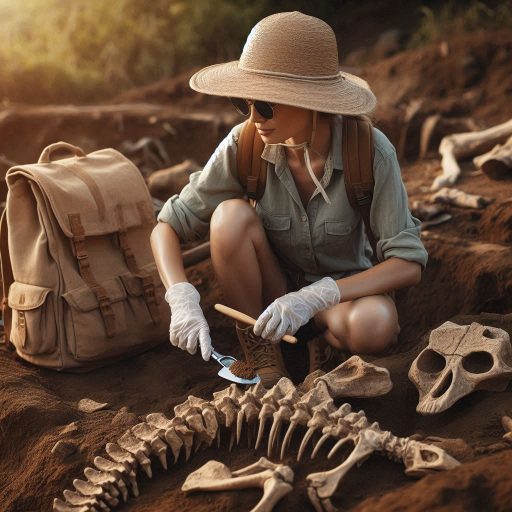Introduction
Technology, in modern anthropology, refers to digital tools and innovations used to study human societies.
These advancements help anthropologists analyze data, conduct research, and engage with cultures more effectively.
With technology, the field of anthropology has evolved, transforming how researchers observe, document, and interact with people globally.
The significance of technology in anthropology is undeniable.
It allows anthropologists to gather data more quickly and accurately.
Digital tools, like 3D modeling, GIS mapping, and virtual reality, have expanded the ways anthropologists visualize human behavior and environments.
This shift has led to deeper insights into cultural diversity, historical migration patterns, and societal changes.
In this blog post, we will explore several key areas where technology has influenced anthropology.
We will discuss how digital tools have revolutionized data collection and analysis.
Then, we will look at virtual tools that help bridge geographical distances between researchers and communities.
We will examine the ethical considerations of using technology in anthropological research, ensuring respect for the cultures being studied.
History of Technology in Anthropology
Technology has played a pivotal role in the evolution of anthropology.
Early anthropologists relied on basic tools like notebooks and sketches to record their findings.
Over time, advancements in technology have transformed how anthropologists conduct research and analyze their data.
Evolution of Technology on the Field of Anthropology
In its early stages, anthropology was a more manual and observational discipline.
Anthropologists used rudimentary tools like maps, drawings, and field journals to document cultures.
Early photography, introduced in the mid-19th century, became one of the first technological breakthroughs.
It allowed researchers to visually capture human behaviors, rituals, and environments, preserving evidence for future analysis.
Photography’s introduction gave anthropologists a more accurate means to record and communicate their findings.
Visual documentation not only enhanced the credibility of their work but also broadened its accessibility to a wider audience.
Technological Advancements in the 20th Century
The 20th century witnessed significant technological developments that reshaped anthropology.
The invention of audio and video recording devices allowed anthropologists to capture conversations, languages, and ceremonies in real-time.
These recordings provided a more authentic representation of cultures compared to written descriptions.
In the mid-20th century, carbon dating technology revolutionized anthropology.
This advancement allowed researchers to determine the age of archaeological artifacts and fossils.
It gave them a more accurate understanding of human history and the evolution of societies.
Computers became an indispensable tool for anthropologists in the late 20th century.
Researchers began using computers for data management, statistical analysis, and the creation of complex models.
This shift reduced the time spent on manual data processing and allowed for more accurate interpretations of findings.
Impact of Digital Technology on Modern Anthropology
Digital technology has fundamentally transformed anthropological research.
The introduction of Geographic Information Systems (GIS) allows anthropologists to map and analyze human settlement patterns over time.
GIS helps researchers visualize complex relationships between cultural and environmental factors, offering new insights into ancient civilizations.
Another major breakthrough came with DNA analysis.
Genetic anthropology now allows researchers to trace human migration patterns, evolution, and kinship relations with unprecedented accuracy.
DNA studies have provided new perspectives on ancient human populations, expanding our understanding of human ancestry.
The internet has also changed the way anthropologists access and share data.
Online databases and digital archives have made vast amounts of anthropological research available to scholars around the world.
This increased access has led to more collaborative research and the dissemination of knowledge across borders.
Modern anthropologists rely heavily on technology for data collection and analysis.
Drones are now used to survey archaeological sites from the air, offering a broader view of landscapes.
3D scanning technology allows anthropologists to create detailed models of artifacts and structures, preserving them for future study.
Advanced software has enhanced the ability to analyze large datasets, which has improved the accuracy of conclusions drawn from fieldwork.
Anthropologists can now manipulate vast amounts of data to find patterns, making their interpretations more comprehensive and reliable.
Technology has continually shaped the field of anthropology.
It has improved how anthropologists collect, interpret, and communicate their findings, leading to a more nuanced understanding of human cultures.
Digital Tools and Data Collection
How digital tools such as GPS, drones, and satellite imagery are used in anthropological fieldwork
Digital tools have transformed anthropological fieldwork significantly.
Technologies like GPS, drones, and satellite imagery enhance data collection methods.
These tools enable anthropologists to gather information more efficiently and accurately.
GPS technology plays a vital role in mapping archaeological sites.
Anthropologists use GPS to document precise locations of artifacts and features.
This accuracy helps researchers analyze spatial relationships between different cultural elements.
It also aids in planning further investigations based on historical land use.
Drones are another valuable asset in modern anthropology.
They provide aerial views of landscapes, allowing researchers to identify patterns otherwise unnoticed.
Drones can quickly survey large areas, saving time and reducing costs associated with traditional methods.
For example, archaeologists used drones to explore ancient Mayan cities in Central America.
This approach revealed structures concealed by dense foliage.
Satellite imagery also plays a significant role in anthropological research.
It offers a broad perspective on geographical changes over time.
Anthropologists can study land use, deforestation, and urbanization from a global viewpoint.
This data helps in understanding how societies interact with their environments.
Advantages and limitations of using digital tools for data collection in anthropology
Despite their advantages, digital tools have limitations in anthropology.
For instance, reliance on technology may overlook local knowledge and context.
Anthropologists must balance technological data with qualitative insights from local communities.
This combination ensures a comprehensive understanding of cultural practices.
Another limitation is the accessibility of technology.
Not all researchers have the resources to utilize advanced digital tools.
Furthermore, technical expertise is required to operate these tools effectively.
Some anthropologists may find it challenging to integrate technology into their traditional methodologies.
Specific examples of how digital tools have revolutionized the data collection process in anthropology
Specific examples illustrate how digital tools have revolutionized data collection in anthropology.
In 2017, researchers used satellite imagery to assess the impact of climate change on the Maasai pastoralists in Kenya.
They analyzed land use changes over time, linking them to social dynamics.
This study showcased how technology can reveal critical insights about human-environment interactions.
Similarly, anthropologists employed drones to document archaeological sites in Iraq.
By mapping ancient cities from the air, they uncovered previously unknown structures.
This approach not only provided new data but also helped preserve cultural heritage.
Digital tools like GPS, drones, and satellite imagery enhance data collection in anthropology.
They offer numerous advantages, such as increased efficiency and accuracy.
However, researchers must remain aware of the limitations and strive to integrate traditional methods with technological advancements.
Embracing this balance can lead to richer, more nuanced anthropological insights.
Read: What Does a Geologist Do? Career Overview and Insights
Technology and Cultural Preservation
Documenting and Preserving Cultural Heritage
Technology plays a vital role in preserving and documenting cultural heritage.
Modern tools allow anthropologists to capture, store, and share cultural practices and artifacts in ways unimaginable before.
Using advanced technology, communities can digitize ancient manuscripts, traditional art, and oral histories.
These efforts prevent cultural elements from being lost over time.
In remote areas, technology enables the documentation of disappearing traditions.
Mobile devices and drones allow anthropologists to record rituals, dances, and ceremonies.
High-quality audio and video equipment capture these events in detail.
This helps preserve cultural knowledge for future generations and offers access to a wider global audience.
Digital Archives, Virtual Reality and 3D Modeling in Cultural Preservation
Digital archives serve as a primary tool for cultural preservation.
These archives store a vast range of historical documents, photos, recordings, and artifacts.
Museums, academic institutions, and indigenous communities can easily share and access this information from any location.
Digital archives make preservation more accessible and reduce the risk of losing valuable cultural materials.
The Smithsonian Institution and UNESCO have spearheaded digital preservation efforts.
They partner with local communities to digitize endangered languages, oral traditions, and historical records.
By housing these materials in secure digital archives, organizations ensure that future generations will have access to these cultural treasures.
Virtual reality (VR) is revolutionizing how we experience and preserve cultures.
VR allows individuals to explore virtual reconstructions of ancient sites and interact with lost cultures.
Through VR, users can “visit” historical landmarks, museums, or cultural spaces without physically being there.
This offers immersive educational opportunities while preserving the integrity of the site.
For example, VR tours of ancient ruins or indigenous lands give users a deeper understanding of cultural practices.
They offer a sense of presence and connection to the past, helping bridge gaps between modern and ancient cultures.
These virtual experiences safeguard delicate environments, reducing damage from human interference.
3D modeling is another technological advancement transforming cultural preservation.
Anthropologists can create exact replicas of artifacts and historical sites using 3D scanning and printing.
These replicas serve both educational and preservation purposes.
If the original artifact is lost or destroyed, a 3D model ensures that it can still be studied.
In addition to protecting physical objects, 3D modeling aids in rebuilding damaged heritage sites.
In places affected by war or natural disasters, 3D technology assists in restoring ancient buildings and monuments.
These models ensure accuracy in reconstruction while maintaining historical integrity.
Balancing Tradition with Technology
While technology offers innovative preservation tools, balancing these with traditional methods is crucial.
Traditional methods, such as oral storytelling or manual documentation, hold cultural value that technology cannot replace.
Cultural preservation efforts should integrate both modern and traditional techniques to respect and maintain authenticity.
By blending old and new, anthropologists can ensure that cultural heritage remains relevant.
Modern technology can support traditional methods, making them more accessible and sustainable over time.
This balance is essential to preserving cultural identity in an ever-changing world.
Read: Educational Path: Becoming a Geologist in the USA
Digital Storytelling and Ethnography
How technology has changed the way ethnographic research is conducted and shared
Technology has significantly transformed ethnographic research methods.
Researchers now utilize various digital tools to enhance their studies.
They can collect data more efficiently and analyze it with advanced software.
Ethnographers increasingly rely on video and audio recordings to capture authentic moments.
This approach provides richer insights into cultural practices and community dynamics.
Digital platforms enable researchers to share findings with broader audiences.
Traditional publications often limit accessibility, but online platforms reach more people.
Researchers can disseminate their work through blogs, websites, and social media.
This shift enhances visibility and invites public engagement with ethnographic studies.
The use of multimedia platforms, social media, and digital storytelling techniques in ethnographic studies
Multimedia platforms play a crucial role in modern ethnographic research.
Ethnographers use videos, podcasts, and interactive websites to present their findings.
These formats allow for more engaging storytelling and provide context for the research.
Social media also facilitates real-time interaction with participants and audiences.
Researchers can share updates, gather feedback, and encourage dialogue around their work.
This immediacy fosters deeper connections between researchers and communities.
It also promotes a sense of collaboration and inclusivity in ethnographic studies.
Digital storytelling techniques enrich ethnographic narratives.
By combining visuals, audio, and text, researchers create immersive experiences.
This approach helps convey complex cultural nuances that traditional methods may overlook.
For instance, video documentaries can showcase rituals, festivals, and daily life, bringing ethnographic research to life.
The impact of digital platforms on representing diverse voices and perspectives in anthropology
Digital platforms have significantly impacted the representation of diverse voices in anthropology.
They democratize knowledge production, allowing marginalized communities to share their stories.
Researchers can amplify these voices by incorporating community narratives into their work.
Moreover, technology enables a more participatory approach to ethnography.
Communities can actively engage in the research process, shaping the narratives that represent them.
This collaboration fosters authenticity and ensures that perspectives are accurately portrayed.
However, challenges remain in ensuring equitable representation.
Not all communities have equal access to digital tools or platforms.
Researchers must be mindful of these disparities and work to bridge the digital divide.
Technology has reshaped the landscape of ethnographic research and storytelling.
By leveraging multimedia platforms, social media, and digital techniques, researchers enhance the richness of their narratives.
This shift allows for more inclusive representation of diverse voices in anthropology.
Embracing these changes can lead to more comprehensive and meaningful understandings of cultural practices.
Read: Botany Career Fairs and Networking Events
Transform Your Career Today
Unlock a personalized career strategy that drives real results. Get tailored advice and a roadmap designed just for you.
Start Now
Ethical Considerations in Using Technology in Anthropology
Challenges and Implications of Using Technology in Anthropological Research
Technology has transformed anthropological research, but it has also introduced new ethical challenges.
The collection, storage, and use of data from participants must be handled with care.
Anthropologists must be mindful of how technology might influence their research process and results.
There is a risk of technology creating a power imbalance between researchers and the communities they study.
The ease of digital data collection can lead to exploitation if ethical guidelines are not followed.
Researchers can access sensitive cultural information through digital platforms, which may not always be intended for them.
This raises questions about the ownership of that data.
In some cases, local communities may not fully understand how their data will be used.
The responsibility falls on the researcher to ensure that they avoid exploiting this access.
These challenges emphasize the need for clear ethical standards when using technology in anthropology.
Privacy Concerns, Consent, And Data Security In The Digital Age
One major issue with technology is the risk of privacy violations.
Anthropological studies often involve sensitive personal data that require careful handling.
With digital tools, the potential for data leaks or breaches increases significantly.
When researchers collect data digitally, they may unintentionally expose participants to privacy risks.
Even with encrypted systems, the possibility of a data breach can never be completely eliminated.
Researchers must consider how their data collection methods affect the communities involved.
Digital tools, such as social media, allow anthropologists to observe communities without physical interaction.
This raises concerns about consent, as participants may not know they are being studied.
Anthropologists must navigate the fine line between observing and intruding on individuals’ private lives.
Ethical practices demand that researchers prioritize participants’ privacy and avoid any actions that could harm them.
Consent is another major ethical concern when using technology in anthropology.
Researchers must ensure that participants fully understand the scope of the study and the implications of providing data.
Digital data collection complicates this process, as participants may not be aware of the long-term consequences.
The use of online surveys, social media analysis, and data mining adds layers of complexity to the informed consent process.
It’s essential that anthropologists offer participants clear, accessible information about how their data will be used.
Additionally, researchers must address potential risks, such as data misuse or unauthorized access.
Anthropologists should take extra steps to secure meaningful consent, especially when working with vulnerable populations.
Strategies for Ensuring Ethical Practices
To address these ethical concerns, anthropologists must adopt rigorous ethical practices when using technology.
One strategy involves developing clear guidelines for data collection, storage, and sharing.
Researchers should work with communities to ensure transparency in the research process.
Another important approach is to use secure digital systems that prioritize data protection.
Anthropologists should also undergo ethics training that covers technology use and data security.
This ensures that they understand the latest ethical standards in the digital age.
Institutions and researchers must establish review boards that assess the ethical impact of technological tools.
Through these measures, anthropologists can integrate technology into their research while maintaining ethical integrity.
Read: Preparing for a Botany PhD: Tips and Advice
Collaborative Research and Interdisciplinary Approaches in Modern Anthropology
How technology is facilitating collaboration among anthropologists and other disciplines
Technology is revolutionizing collaboration among anthropologists and other fields.
Researchers now use online platforms to share data and insights.
These platforms enable real-time communication across geographical boundaries.
Anthropologists collaborate with biologists, sociologists, and environmental scientists on various projects.
This multidisciplinary approach enhances research quality and broadens perspectives on cultural issues.
Moreover, virtual meeting tools facilitate discussions and brainstorming sessions.
These tools allow teams to work together efficiently, regardless of location.
Collaborative software enables the sharing of documents and data, streamlining the research process.
Consequently, researchers can synthesize ideas and develop innovative solutions to complex questions.
The benefits of interdisciplinary approaches in addressing complex anthropological questions
Interdisciplinary approaches address complex anthropological questions effectively.
They integrate diverse methodologies and perspectives, enriching the research process.
For example, combining anthropology with public health can reveal cultural factors affecting health behaviors.
This collaboration leads to more comprehensive solutions to public health challenges.
Furthermore, interdisciplinary teams foster creativity and innovation.
Researchers from different backgrounds contribute unique insights, driving the exploration of new ideas.
This synergy enhances problem-solving capabilities and leads to novel research outcomes.
Addressing issues like climate change requires input from multiple disciplines, including anthropology, geography, and environmental science.
By embracing interdisciplinary collaboration, researchers can tackle urgent global challenges.
They can address issues such as migration, inequality, and resource management more effectively.
This approach produces research with practical applications, benefiting communities and policymakers.
Successful examples of collaborative research projects that leverage technology in anthropology
Several successful collaborative research projects exemplify the power of technology in anthropology.
One notable project involves anthropologists and data scientists analyzing social media data.
They studied how online interactions influence cultural trends and community behaviors.
This project illustrates how combining disciplines can yield valuable insights into contemporary social dynamics.
Another example is the ‘Global Indigenous Data Alliance‘ initiative.
This project unites anthropologists, indigenous communities, and data scientists.
They work together to develop ethical frameworks for data collection and sharing.
This collaboration empowers indigenous communities and respects their data sovereignty.
The ‘Digital Archaeological Archive of Comparative Slavery‘ project also showcases interdisciplinary collaboration.
This initiative combines anthropology, archaeology, and history to document the experiences of enslaved people.
Researchers use digital tools to create a comprehensive database that highlights diverse narratives.
Technology enhances collaboration among anthropologists and other disciplines.
Interdisciplinary approaches address complex questions and promote innovation.
Successful projects demonstrate the potential of collaborative research in anthropology.
By leveraging technology, researchers can produce impactful work that benefits both academia and society.
The Future of Technology in Anthropology
Emerging technologies and trends that could shape the future of anthropology
Emerging technologies are poised to transform anthropology significantly.
Artificial intelligence (AI) will enhance data analysis and interpretation.
Anthropologists can use AI to identify patterns in large datasets, uncovering insights that manual analysis might miss.
Additionally, machine learning algorithms will aid in processing ethnographic data more efficiently.
Virtual reality (VR) and augmented reality (AR) also offer exciting possibilities.
These technologies can create immersive environments for ethnographic research.
Researchers can simulate cultural experiences, enabling deeper understanding and engagement.
This approach may allow anthropologists to study cultural practices in new and innovative ways.
Furthermore, advancements in wearable technology will facilitate data collection.
Researchers can gather real-time biometric data, enhancing their understanding of cultural behaviors.
This trend will provide richer insights into the relationship between culture and biology.
Potential challenges and opportunities that technology may present for the field of anthropology
While technology presents numerous opportunities, it also poses challenges.
Ethical concerns about privacy and consent will increase as data collection becomes more pervasive.
Anthropologists must navigate these issues carefully, ensuring respect for participants‘ rights.
Moreover, the digital divide remains a significant challenge.
Access to technology varies greatly among communities, potentially leading to disparities in research representation.
Anthropologists must advocate for equitable access to technology and resources.
Additionally, reliance on technology can lead to oversimplification of complex cultural dynamics.
Researchers must remain critical of their tools and methodologies, ensuring they do not compromise the depth of their analyses.
How anthropologists can adapt to and leverage technological advancements in their research
To adapt to technological advancements, anthropologists must embrace lifelong learning.
They should stay updated on emerging technologies and their potential applications in the field.
Participating in workshops and training sessions will enhance their skills and knowledge.
Collaboration with technologists and data scientists will also be crucial.
Anthropologists can benefit from interdisciplinary partnerships, gaining insights into new tools and methods.
By working together, they can create innovative research projects that combine anthropology and technology.
Furthermore, anthropologists should prioritize ethical considerations when using technology.
Developing ethical guidelines for technology use will help protect research participants.
This focus will ensure that technology enhances, rather than detracts from, anthropological research.
The future of technology in anthropology holds great promise.
Emerging technologies like AI, VR, and wearable devices will shape research methodologies.
While challenges exist, anthropologists can adapt by embracing new tools and prioritizing ethical practices.
By leveraging technological advancements, they can continue to contribute valuable insights into human culture and society.
Discover More: Future Trends in Plant Science Research
Discover More: Essential Epidemiology Books for Aspiring Professionals
Conclusion
Technology profoundly transforms modern anthropology, reshaping how researchers gather and analyze data.
It enhances fieldwork with tools like drones and mobile applications.
These advancements enable anthropologists to reach remote areas and collect real-time information.
Furthermore, social media platforms offer new avenues for understanding cultural dynamics.
Researchers can now analyze trends and interactions on a global scale.
Digital archives and databases have revolutionized access to anthropological resources.
They allow scholars to connect with diverse cultures and histories efficiently.
Moreover, virtual reality and immersive technologies enable experiential learning, bridging gaps between theory and practice.
By incorporating these innovations, anthropologists gain fresh perspectives on age-old questions.
As technology continues to evolve, it opens new frontiers for anthropological research.
The intersection of technology and anthropology invites scholars to rethink traditional methodologies.
Readers are encouraged to explore this dynamic relationship in their research and practice.
By embracing these tools, they can uncover deeper insights into human behavior and culture.
Technology enriches the anthropological journey, making it more inclusive and expansive.
Engaging with this exciting field can lead to groundbreaking discoveries and foster a greater understanding of our shared humanity.




